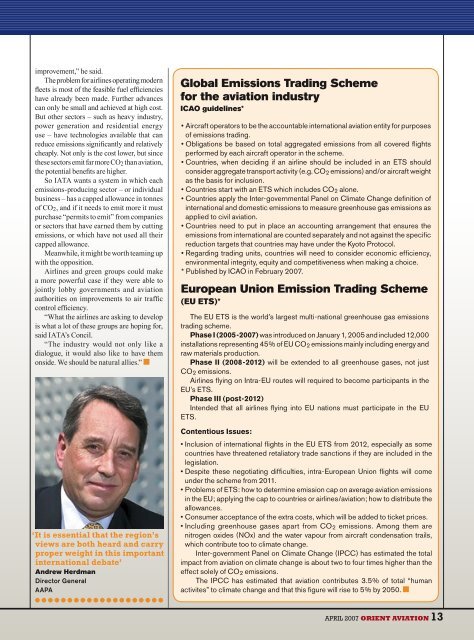Fleet Census - Orient Aviation
Fleet Census - Orient Aviation
Fleet Census - Orient Aviation
You also want an ePaper? Increase the reach of your titles
YUMPU automatically turns print PDFs into web optimized ePapers that Google loves.
improvement,” he said.<br />
The problem for airlines operating modern<br />
fleets is most of the feasible fuel efficiencies<br />
have already been made. Further advances<br />
can only be small and achieved at high cost.<br />
But other sectors – such as heavy industry,<br />
power generation and residential energy<br />
use – have technologies available that can<br />
reduce emissions significantly and relatively<br />
cheaply. Not only is the cost lower, but since<br />
these sectors emit far more CO 2 than aviation,<br />
the potential benefits are higher.<br />
So IATA wants a system in which each<br />
emissions-producing sector – or individual<br />
business – has a capped allowance in tonnes<br />
of CO 2 , and if it needs to emit more it must<br />
purchase “permits to emit” from companies<br />
or sectors that have earned them by cutting<br />
emissions, or which have not used all their<br />
capped allowance.<br />
Meanwhile, it might be worth teaming up<br />
with the opposition.<br />
Airlines and green groups could make<br />
a more powerful case if they were able to<br />
jointly lobby governments and aviation<br />
authorities on improvements to air traffic<br />
control efficiency.<br />
“What the airlines are asking to develop<br />
is what a lot of these groups are hoping for,<br />
said IATA’s Concil.<br />
“The industry would not only like a<br />
dialogue, it would also like to have them<br />
onside. We should be natural allies.”<br />
‘It is essential that the region’s<br />
views are both heard and carry<br />
proper weight in this important<br />
international debate’<br />
Andrew Herdman<br />
Director General<br />
AAPA<br />
Global Emissions Trading Scheme<br />
for the aviation industry<br />
ICAO guidelines*<br />
• Aircraft operators to be the accountable international aviation entity for purposes<br />
of emissions trading.<br />
• Obligations be based on total aggregated emissions from all covered flights<br />
performed by each aircraft operator in the scheme.<br />
• Countries, when deciding if an airline should be included in an ETS should<br />
consider aggregate transport activity (e.g. CO 2 emissions) and/or aircraft weight<br />
as the basis for inclusion.<br />
• Countries start with an ETS which includes CO 2 alone.<br />
• Countries apply the Inter-governmental Panel on Climate Change definition of<br />
international and domestic emissions to measure greenhouse gas emissions as<br />
applied to civil aviation.<br />
• Countries need to put in place an accounting arrangement that ensures the<br />
emissions from international are counted separately and not against the specific<br />
reduction targets that countries may have under the Kyoto Protocol.<br />
• Regarding trading units, countries will need to consider economic efficiency,<br />
environmental integrity, equity and competitiveness when making a choice.<br />
* Published by ICAO in February 2007.<br />
European Union Emission Trading Scheme<br />
(EU ETS)*<br />
The EU ETS is the world’s largest multi-national greenhouse gas emissions<br />
trading scheme.<br />
Phase I (2005-2007) was introduced on January 1, 2005 and included 12,000<br />
installations representing 45% of EU CO 2 emissions mainly including energy and<br />
raw materials production.<br />
Phase II (2008-2012) will be extended to all greenhouse gases, not just<br />
CO 2 emissions.<br />
Airlines flying on Intra-EU routes will required to become participants in the<br />
EU’s ETS.<br />
Phase III (post-2012)<br />
Intended that all airlines flying into EU nations must participate in the EU<br />
ETS.<br />
Contentious Issues:<br />
• Inclusion of international flights in the EU ETS from 2012, especially as some<br />
countries have threatened retaliatory trade sanctions if they are included in the<br />
legislation.<br />
• Despite these negotiating difficulties, intra-European Union flights will come<br />
under the scheme from 2011.<br />
• Problems of ETS: how to determine emission cap on average aviation emissions<br />
in the EU; applying the cap to countries or airlines/aviation; how to distribute the<br />
allowances.<br />
• Consumer acceptance of the extra costs, which will be added to ticket prices.<br />
• Including greenhouse gases apart from CO 2 emissions. Among them are<br />
nitrogen oxides (NOx) and the water vapour from aircraft condensation trails,<br />
which contribute too to climate change.<br />
Inter-government Panel on Climate Change (IPCC) has estimated the total<br />
impact from aviation on climate change is about two to four times higher than the<br />
effect solely of CO 2 emissions.<br />
The IPCC has estimated that aviation contributes 3.5% of total “human<br />
activites” to climate change and that this figure will rise to 5% by 2050.<br />
APRIL 2007 ORIENT AVIATION 13








![OAMag-V7N4-Cover [Converted] - Orient Aviation](https://img.yumpu.com/48598575/1/190x255/oamag-v7n4-cover-converted-orient-aviation.jpg?quality=85)








